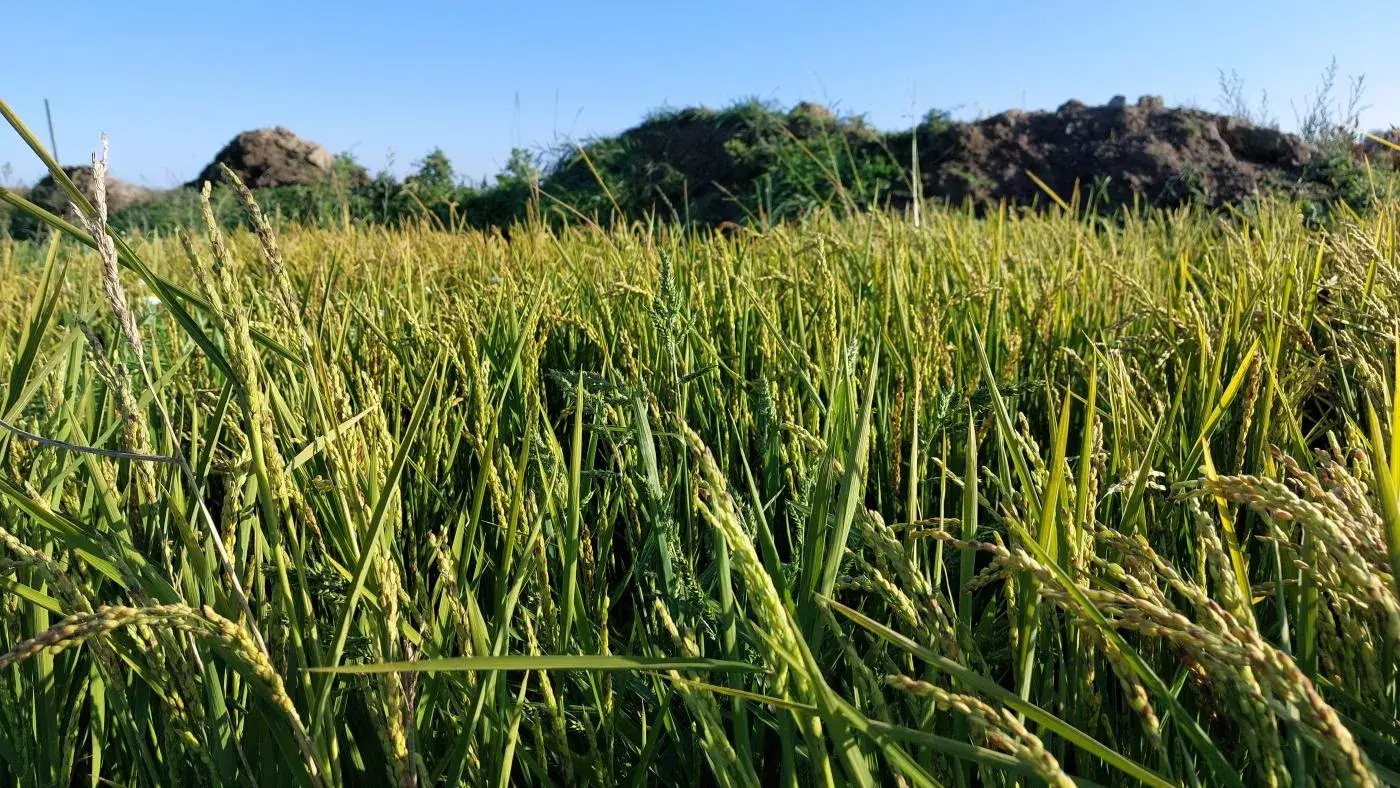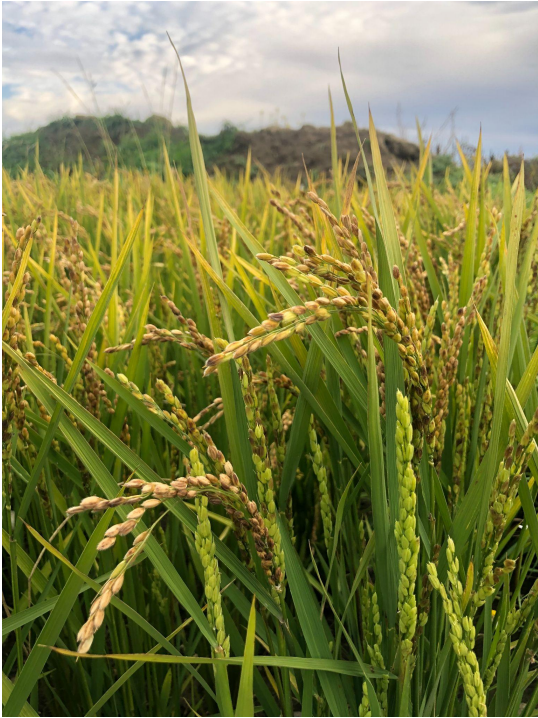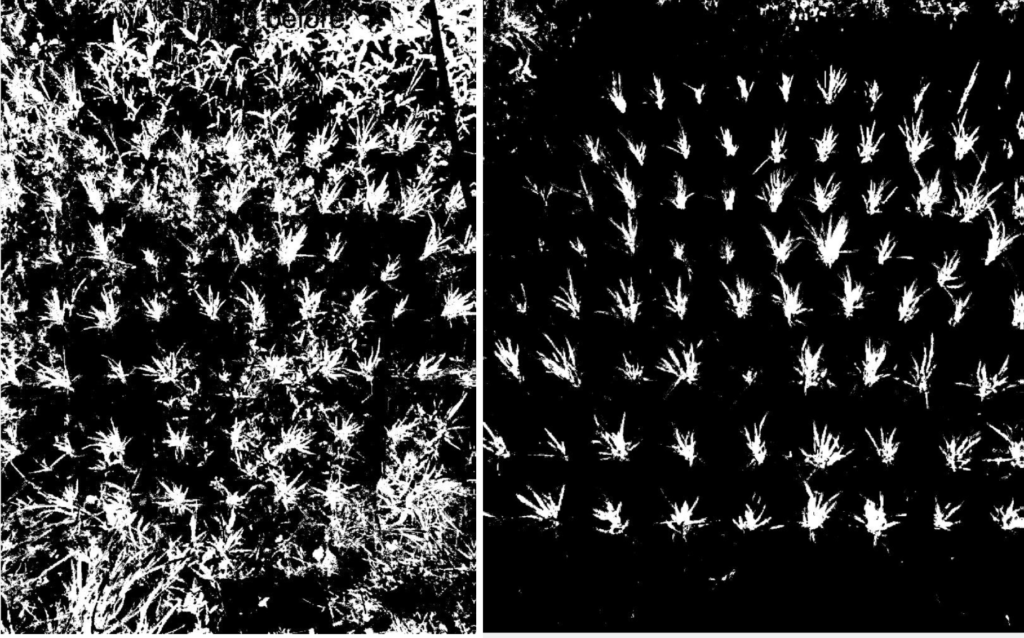

Rice yield was higher in flooded paddies than dry field plots and was unaffected by paper mulch.
Sustainable Agriculture Student Research Project
Effects of Flooding and Paper Mulch on Fraser Valley RiceWendel Vistan, Department of Sustainable Agriculture, 2023 |
Introduction
- Rice (Oryza sativa) is commonly grown from transplants in flooded paddy systems. It is grown in more than 113 countries throughout the world with Asia being the top producer.
- Dry-field production is an alternative production method. It is grown similarly to other grains where it grows on dry plots of land. The benefit of it is that it consumes less water and produces lower methane emissions but a major constraint is the emergence of weeds.
- Flooded rice have lower weed pressure but are heavy consumers of water with high methane emissions. Rice production in flooded paddies produce 10% of the global methane emissions.
- Paper mulch is a biodegradable product made for weed suppression. The paper mulch is presumed to inhibit weed growth as the rice grows after being transplanted. By the time the paper mulch has decomposed (40-50 days), the rice should be well established enough to provide canopy cover overall reducing the amount of labour in organic production.
Objectives
- Compare the yield and weed pressure between the flooded and dry-field production systems.
- Test paper mulch as a weed management strategy in both systems.
Methods
Location: KPU Farm, Garden City Lands, Richmond, BC
Experimental Design: Completely randomized split-plot design with 3 replicates (Figure 1).
- Main plot treatments: flooded or dry-field rice.
- Subplot treatments: paper mulch or no paper mulch (Figure 2).

Figure 1. Rice plot randomization using a Completely Randomized Split-Plot Design with three replicates.

Figure 2. Transplanted dryland rice in paper mulch on June 8, 2023.
- Irrigation: Constant drip in flooded plots and over-head in dry plots.
- Rice transplanted on June 7, 2023 and harvested on October 22, 2023.
- Before planting, each plot was applied with an inch compost for nutrients.
- Rice grains were soaked until germination. Germinated seeds were sown into trays of soil. Each tray consisted of approximately 400 seeds. The seeds grew up to 3-4 inches and were transplanted into the ground with 3 plants per hole.
- 4-4-4 fertilizer was added to each plot after yellowing on the leaves started to appear.

Figure 3. Transplanted rice in flooded systems on July 13, 2023.
- Rice was harvested in 1 m x 1 m subsample from each subplot (Figs. 4, 5).
- It was hung to dry for 15 days (Fig. 6), threshed by hand (Fig. 7), and winnowed with an air separator.
- Data collected: Rice grain weight and the percentage of weeds removed from each plot.
- Statistical analysis: Mixed Model analysis in jamovi

Figure 4. Mature rice in flooded plot on October 13, 2023.

Figure 5. Rice subplot after harvest from a 1 m x 1 m square.

Figure 6. Rice sheaves hung to dry for 15 days in solar dome greenhouse.

Figure 7. Hand-threshing rice grain into a bucket.
Results
- Flooded plots yielded more rice than dry plots (206 and 11 g/m² in flooded and dry, respectively) (Fig. 8)
- Paper mulch had no effect on rice yield

Figure 8. Dry rice grain yield from the flooded plots and dry plots. Error bars denote standard error. Means labelled with the same letter do not differ significantly. (Bonferroni test. n = 3, a = 0.05).
- The three dryland plots without paper mulch were weeded once. The average weed cover removed amounted to 11.0 +/- 5.5% of the soil surface area. Unfortunately, no data was taken from the paper mulch side to compare the difference in between weeds produced from non-paper mulch and paper mulch side. An example of canopy cover images before and after weeding is shown in Fig. 9.

Figure 9. Canopy coverage before weeding (left, 29.25%) and after weeding a rice plot (right, 8.81%), as measured by Canopeo.
- Mulch had no effect on crop yield.
- Paper mulch decomposed before canopy cover could establish (Fig. 10).
- This may be caused by wind catching the paper mulch and ripping some parts of it as well as not being able to weight the paper mulch down properly for the dry plots.

Figure 10. Paper mulch decomposing in flooded rice plot.
Discussion
The lower yield in the dry plots may have been affected by inconsistent watering at the beginning of the season. Each plot drained at different rates, requiring different irrigation frequency in each plot, which made it difficult to keep standing water at a consistent level throughout the establishment period.
Conclusion
- Flooded plots produced more grain weight compared to dry plots.
- Paper mulch had no effect on the yield.
Acknowledgements
Thank you to Dr. Mike Bomford, Andy Smith, and Sahar Zandieh for their help, support and guidance throughout this project.
Thank you to Masa Shiroki and Akio Nakamura (Artisan Sake Maker) for their mentorship with this research.
Thank you to Jared Bance for assistance throughout the season.
